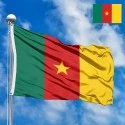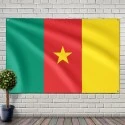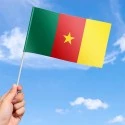The national flag of the Republic of Cameroon is a vibrant and deeply symbolic emblem that encapsulates the nation's journey from colonial division to a unified, independent state. Adopted on May 20, 1975, the flag represents the culmination of historical struggles, the rich cultural diversity of its people, and its aspirations for peace, unity, and prosperity. Its design, steeped in Pan-African tradition and infused with unique national meaning, makes it an instantly recognizable and powerful symbol of Cameroon's identity.
Design and Symbolism: A Star of Unity and Prosperity
The flag of Cameroon is a vertical tricolor of green, red, and yellow, with a single golden star prominently placed in the center of the red stripe. Each color and the star carry profound national significance:
-
Green (Left Stripe): The leftmost stripe is a verdant green. This color powerfully symbolizes the lush vegetation, the rich forests, and the agricultural wealth of Cameroon. It represents the nation's abundant natural resources, its fertile land, and its strong connection to the environment. It also signifies hope for a prosperous future, drawing on the country's agricultural potential.
-
Red (Central Stripe): The central stripe is a bold red. This color serves as a potent symbol of unity and national sovereignty. It represents the blood shed by the nation's heroes in their struggle for independence and the sacrifices made to forge a unified state from its diverse linguistic and cultural regions. The red stripe acts as the central pillar, connecting the north and south of the country, reflecting the commitment to national cohesion.
-
Yellow (Right Stripe): The rightmost stripe is a radiant yellow. This color symbolizes the sun and the savannas found in the northern regions of Cameroon. It represents the golden future that the nation strives for, embodying happiness, joy, and the wealth derived from its natural resources. It also alludes to the sun's role in sustaining life and fostering growth.
-
Golden Star (Center of Red Stripe): The most distinctive feature of the flag is the single, five-pointed golden star placed centrally within the red stripe. This star is the "Star of Unity" and holds multifaceted symbolism:
-
Unity: Primarily, the star symbolizes the unity of the nation, bringing together the formerly distinct French and British Cameroons into a single, cohesive republic. It emphasizes the importance of overcoming historical divisions.
-
Prosperity and Guidance: The star also represents the guidance and good fortune that illuminate the nation's path towards prosperity and a bright future. It is a beacon of hope and a reminder of the country's aspirations.
-
Original Two Stars: Historically, from 1961 to 1975, the flag featured two golden stars in the green stripe, representing the two federated states (East Cameroon, primarily French-speaking, and West Cameroon, primarily English-speaking). The transition to a single star in 1975, upon the formation of a unitary state, strongly reinforced the message of national unity and integration.
The overall design of the flag effectively conveys a message of a fertile and resource-rich land (green), whose people are united by shared sacrifices (red) and aspire to a bright, prosperous future (yellow), all guided by the principle of national unity (star).
Dimensions and Proportions:
The official proportions of the Flag of Cameroon are a width-to-length ratio of 2:3. This is a standard and common ratio for many national flags, ensuring visual balance and ease of reproduction. The three vertical stripes (green, red, and yellow) are of equal width. The central golden star is proportionally sized to be prominent without overwhelming the stripes, typically occupying a significant portion of the red stripe's width and height. Its exact dimensions are defined in the heraldic specifications to maintain consistency.
History and Evolution: From Division to Unification
The history of the Cameroonian flag is a compelling narrative of colonial partition, reunification, and the forging of a singular national identity.
-
German Colonial Period (Kamerun): Before World War I, Cameroon was a German protectorate known as Kamerun. During this period, the official flag was the German imperial flag (black, white, red horizontal tricolor). There was no specific colonial flag with distinct Cameroonian symbolism.
-
Post-World War I Mandate Territories (French and British Cameroons): After Germany's defeat in WWI, the League of Nations divided Kamerun into two mandate territories administered by France and Britain.
-
French Cameroons: This larger eastern part, predominantly French-speaking, eventually became independent as the Republic of Cameroon in 1960. Their initial flag, adopted on October 29, 1957, was the green, red, and yellow vertical tricolor without a star. These Pan-African colors were chosen to symbolize the nation's African heritage, its struggle, and its aspirations.
-
British Cameroons: This smaller western part, predominantly English-speaking, was further divided. The northern part voted to join Nigeria, while the southern part (Southern Cameroons) voted to join the newly independent Republic of Cameroon.
-
Federation and the Two-Star Flag (1961-1975): On October 1, 1961, the Southern Cameroons joined the Republic of Cameroon, forming the Federal Republic of Cameroon. To reflect this federal structure and the union of two distinct linguistic and administrative entities, the flag was modified. Two golden stars were added to the upper part of the green stripe, symbolizing the two federated states (East Cameroon and West Cameroon). This flag was a powerful symbol of the newfound unity despite the historical colonial divisions.
-
Unitary State and the Single-Star Flag (1975-Present): On May 20, 1972, the federal structure was abolished, and Cameroon became a unitary state – the United Republic of Cameroon. This constitutional change reflected a desire for stronger national integration and a more centralized government. However, the flag was officially changed to its current design on May 20, 1975, when the two stars were replaced by a single, larger golden star placed centrally in the red stripe. This single star powerfully reinforced the concept of a unified, indivisible nation, overcoming its dual colonial legacy.
The evolution of the Cameroonian flag directly mirrors the nation's political and social development, marking its transition from fragmented colonial territories to a unified and sovereign republic.
Regional Context and Central African Identity:
Cameroon is often referred to as "Africa in miniature" due to its incredible geographical and cultural diversity, encompassing savannas, mountains, rainforests, and a coastline on the Atlantic Ocean (Bight of Biafra). It is strategically located in Central Africa, bordering Nigeria, Chad, Central African Republic, Equatorial Guinea, Gabon, and the Republic of the Congo.
The Cameroonian flag, with its green, red, and yellow vertical tricolor, explicitly employs the Pan-African colors. These colors, popularized by Marcus Garvey's Universal Negro Improvement Association and African Communities League (UNIA-ACL), were adopted by many African nations upon gaining independence as a symbol of African unity, freedom, and solidarity. While sharing this color scheme with countries like Guinea, Mali, and Senegal (albeit in different orders or with different central emblems), Cameroon's flag uniquely incorporates the single central golden star. This star serves to distinguish Cameroon's specific journey of post-colonial reunification and its aspiration for singular national identity, setting it apart within the broader Pan-African vexillological tradition. It represents Cameroon's commitment to African solidarity while simultaneously asserting its unique national character and its successful unification despite its complex colonial past.
Interesting Facts:
-
"Africa in Miniature": Cameroon is often called "Africa in miniature" due a diverse landscape and culture, reflected in its flag's colors (green for forests, yellow for savannas).
-
Pan-African Colors: The green, red, and yellow are the traditional Pan-African colors, symbolizing African unity, the struggle for freedom, and the continent's natural wealth.
-
Evolution of Stars: The flag initially had no stars (1957-1961), then two stars (1961-1975) to represent the federated English and French-speaking regions, before settling on the single star (1975-Present) for unity.
-
Symbol of Unity: The single golden star in the center is explicitly known as the "Star of Unity," symbolizing the nation's successful integration despite its dual colonial heritage.
-
Vertical Tricolor: While many flags use horizontal stripes, Cameroon's vertical tricolor with a central emblem gives it a distinctive appearance.
-
Adopted on National Day: The current flag was officially adopted on May 20, 1975, which is also Cameroon's National Day (Unitary State Day), reinforcing its significance.
-
Independence First: The green-red-yellow tricolor without stars was the flag of French Cameroon upon its independence in 1960, before the reunification.
-
Blood of Martyrs: The red stripe specifically refers to the blood shed by martyrs and heroes of the independence struggle, emphasizing the cost of freedom.
-
Sun and Savanna: The yellow color is often associated with the sun and the vast savannas found in the northern parts of the country, highlighting geographical diversity.
-
Hope for Prosperity: The green color signifies hope and the promise of prosperity through Cameroon's abundant agricultural and natural resources.
Significance for the Inhabitants: A Proud Emblem of Unity, Resilience, and Aspiration
For the people of Cameroon, their national flag is much more than a mere piece of cloth; it is a profound and living symbol that encapsulates their collective history, identity, and aspirations. It evokes deep feelings of patriotism, pride, and solidarity, serving as a constant reminder of the journey their nation has undertaken and the values that define them.
The green stripe resonates deeply with the natural bounty of Cameroon – its lush forests, fertile lands, and diverse ecosystems. It symbolizes the promise of agricultural prosperity and the vital connection to their ancestral land, fostering a sense of stewardship and appreciation for their natural heritage. This color instills hope for a future built on sustainable growth and abundance.
The red stripe, positioned centrally, is a powerful and poignant reminder of the sacrifices made by the nation's heroes in their struggle for independence and the subsequent efforts to forge unity from historical divisions. It honors the courage and determination of those who shed their blood for freedom, ensuring that their legacy remains etched in the national consciousness. This color serves as a call for continued national cohesion and a shared commitment to overcome any challenges that threaten unity.
The yellow stripe embodies the warmth of the Cameroonian sun, the spirit of optimism, and the aspiration for a golden future. It represents the happiness, joy, and the wealth that the nation strives to achieve for all its citizens. It also subtly acknowledges the geographical diversity of the country, particularly the savannas of the north.
The single golden star, prominently placed in the heart of the flag, is arguably the most significant element for Cameroonians. It is the "Star of Unity," representing the successful integration of the formerly disparate English and French-speaking regions into one indivisible nation. For many, it symbolizes the triumph over colonial legacies of division and the unwavering commitment to a unified identity. It is a beacon of hope and a guiding light, reminding every citizen that despite their diverse backgrounds, they are one people, striving together towards a common destiny.
Displayed with immense respect during national holidays, at sporting events, in schools, and in daily life, the Cameroonian flag acts as a powerful unifying emblem. It transcends linguistic, tribal, and political differences, serving as a constant source of inspiration and a rallying point for collective action towards a harmonious, prosperous, and secure future for all Cameroonians. It truly embodies the spirit of a nation that has overcome division to stand united under one proud banner.
In the demonstration images, full-size flags are shown with proportions of 2:3, and hand-held flags with proportions of 1:2.






 Waving flag
Waving flag
 Sizes:
Sizes:
 Round flag
Round flag
 Sizes:
Sizes:
 Rectangular flag 2:3
Rectangular flag 2:3
 Sizes:
Sizes: